Organisational Behaviour: Motivation, IiP, and Cultural Impact Report
VerifiedAdded on 2022/09/28
|11
|2239
|20
Report
AI Summary
This report delves into the multifaceted concept of motivation within organizational behaviour. It begins by outlining the fundamental characteristics of motivation and analyzing the effectiveness of the Investors in People (IiP) program in enhancing employee motivation. The report then explores McClelland's Theory of Needs, explaining its relevance in motivating staff and providing practical applications for human resource management. Furthermore, the report critically examines the cultural differences between the UK and Jamaica, discussing why motivational strategies like IiP may not translate effectively across cultures. Finally, the report investigates the reasons why some employers did not participate in the IiP scheme, identifying factors such as underestimation of human resource management importance, financial considerations, and concerns about training's impact on productivity. The report concludes by synthesizing these insights, offering a comprehensive understanding of motivation's role in organizational success and the challenges of implementing motivational strategies across diverse cultural contexts.

1
Organisational Behaviour
ORGANIZATIONAL BEHAVIOUR –
1098459
Organisational Behaviour
ORGANIZATIONAL BEHAVIOUR –
1098459
Paraphrase This Document
Need a fresh take? Get an instant paraphrase of this document with our AI Paraphraser
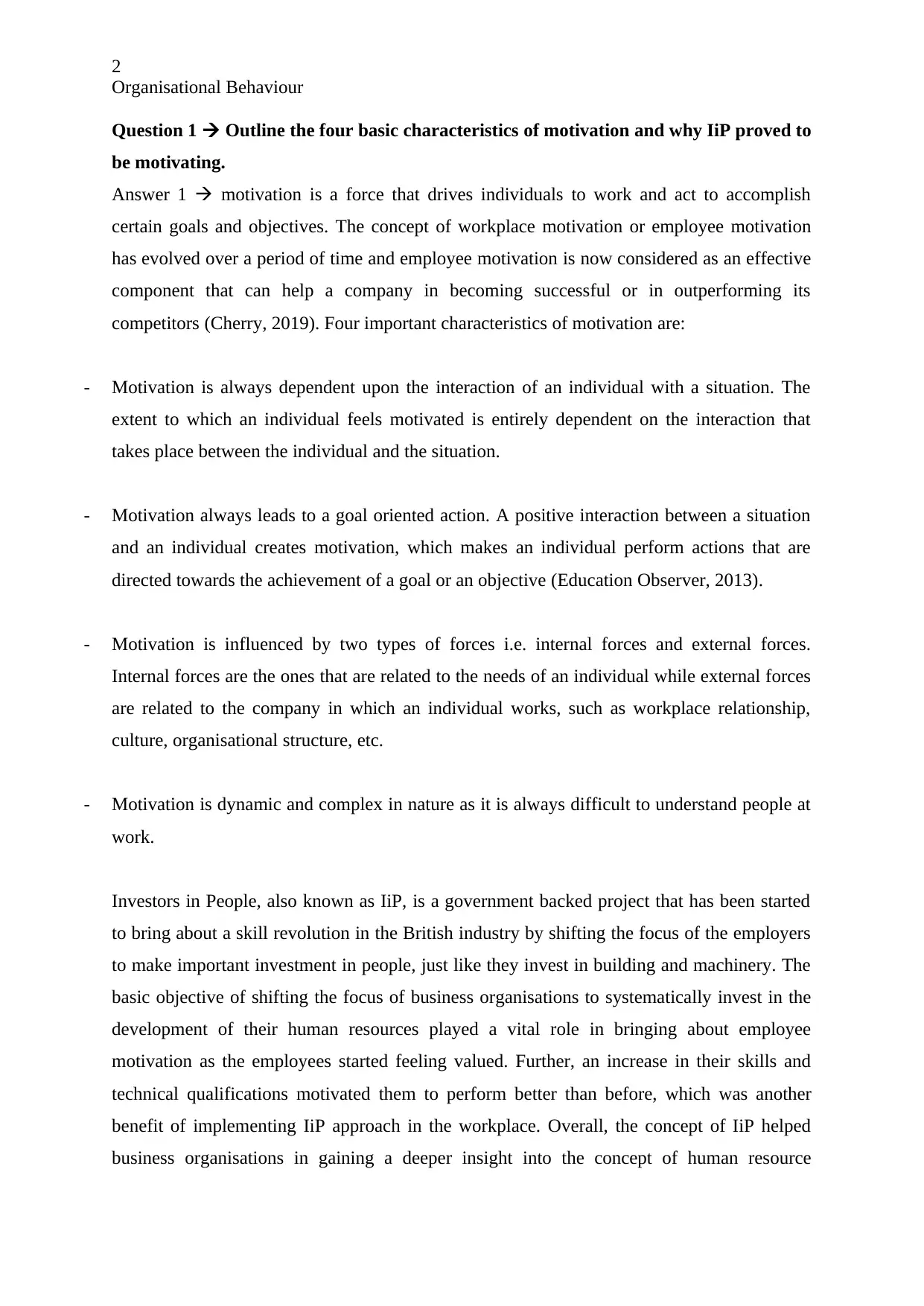
2
Organisational Behaviour
Question 1 Outline the four basic characteristics of motivation and why IiP proved to
be motivating.
Answer 1 motivation is a force that drives individuals to work and act to accomplish
certain goals and objectives. The concept of workplace motivation or employee motivation
has evolved over a period of time and employee motivation is now considered as an effective
component that can help a company in becoming successful or in outperforming its
competitors (Cherry, 2019). Four important characteristics of motivation are:
- Motivation is always dependent upon the interaction of an individual with a situation. The
extent to which an individual feels motivated is entirely dependent on the interaction that
takes place between the individual and the situation.
- Motivation always leads to a goal oriented action. A positive interaction between a situation
and an individual creates motivation, which makes an individual perform actions that are
directed towards the achievement of a goal or an objective (Education Observer, 2013).
- Motivation is influenced by two types of forces i.e. internal forces and external forces.
Internal forces are the ones that are related to the needs of an individual while external forces
are related to the company in which an individual works, such as workplace relationship,
culture, organisational structure, etc.
- Motivation is dynamic and complex in nature as it is always difficult to understand people at
work.
Investors in People, also known as IiP, is a government backed project that has been started
to bring about a skill revolution in the British industry by shifting the focus of the employers
to make important investment in people, just like they invest in building and machinery. The
basic objective of shifting the focus of business organisations to systematically invest in the
development of their human resources played a vital role in bringing about employee
motivation as the employees started feeling valued. Further, an increase in their skills and
technical qualifications motivated them to perform better than before, which was another
benefit of implementing IiP approach in the workplace. Overall, the concept of IiP helped
business organisations in gaining a deeper insight into the concept of human resource
Organisational Behaviour
Question 1 Outline the four basic characteristics of motivation and why IiP proved to
be motivating.
Answer 1 motivation is a force that drives individuals to work and act to accomplish
certain goals and objectives. The concept of workplace motivation or employee motivation
has evolved over a period of time and employee motivation is now considered as an effective
component that can help a company in becoming successful or in outperforming its
competitors (Cherry, 2019). Four important characteristics of motivation are:
- Motivation is always dependent upon the interaction of an individual with a situation. The
extent to which an individual feels motivated is entirely dependent on the interaction that
takes place between the individual and the situation.
- Motivation always leads to a goal oriented action. A positive interaction between a situation
and an individual creates motivation, which makes an individual perform actions that are
directed towards the achievement of a goal or an objective (Education Observer, 2013).
- Motivation is influenced by two types of forces i.e. internal forces and external forces.
Internal forces are the ones that are related to the needs of an individual while external forces
are related to the company in which an individual works, such as workplace relationship,
culture, organisational structure, etc.
- Motivation is dynamic and complex in nature as it is always difficult to understand people at
work.
Investors in People, also known as IiP, is a government backed project that has been started
to bring about a skill revolution in the British industry by shifting the focus of the employers
to make important investment in people, just like they invest in building and machinery. The
basic objective of shifting the focus of business organisations to systematically invest in the
development of their human resources played a vital role in bringing about employee
motivation as the employees started feeling valued. Further, an increase in their skills and
technical qualifications motivated them to perform better than before, which was another
benefit of implementing IiP approach in the workplace. Overall, the concept of IiP helped
business organisations in gaining a deeper insight into the concept of human resource

3
Organisational Behaviour
management and the benefits that can be achieved by treating human resources as an equally
important resource as is a plant, machinery or a building. As a result, the organisations that
had signed up for the IiP program were able to experience higher performance and motivation
levels amongst their staff members because of an improvement in their human resource
management practices.
Organisational Behaviour
management and the benefits that can be achieved by treating human resources as an equally
important resource as is a plant, machinery or a building. As a result, the organisations that
had signed up for the IiP program were able to experience higher performance and motivation
levels amongst their staff members because of an improvement in their human resource
management practices.
⊘ This is a preview!⊘
Do you want full access?
Subscribe today to unlock all pages.

Trusted by 1+ million students worldwide
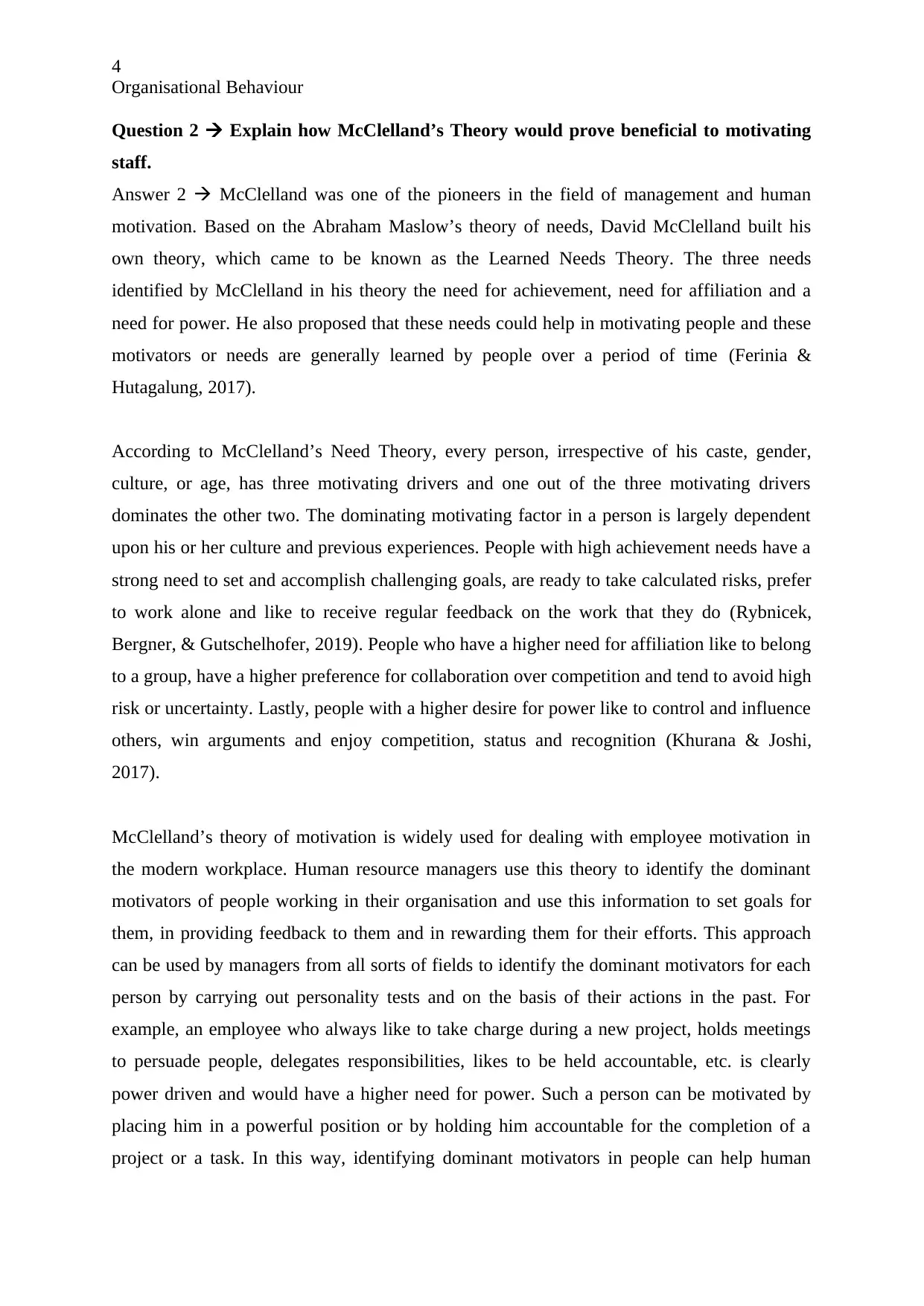
4
Organisational Behaviour
Question 2 Explain how McClelland’s Theory would prove beneficial to motivating
staff.
Answer 2 McClelland was one of the pioneers in the field of management and human
motivation. Based on the Abraham Maslow’s theory of needs, David McClelland built his
own theory, which came to be known as the Learned Needs Theory. The three needs
identified by McClelland in his theory the need for achievement, need for affiliation and a
need for power. He also proposed that these needs could help in motivating people and these
motivators or needs are generally learned by people over a period of time (Ferinia &
Hutagalung, 2017).
According to McClelland’s Need Theory, every person, irrespective of his caste, gender,
culture, or age, has three motivating drivers and one out of the three motivating drivers
dominates the other two. The dominating motivating factor in a person is largely dependent
upon his or her culture and previous experiences. People with high achievement needs have a
strong need to set and accomplish challenging goals, are ready to take calculated risks, prefer
to work alone and like to receive regular feedback on the work that they do (Rybnicek,
Bergner, & Gutschelhofer, 2019). People who have a higher need for affiliation like to belong
to a group, have a higher preference for collaboration over competition and tend to avoid high
risk or uncertainty. Lastly, people with a higher desire for power like to control and influence
others, win arguments and enjoy competition, status and recognition (Khurana & Joshi,
2017).
McClelland’s theory of motivation is widely used for dealing with employee motivation in
the modern workplace. Human resource managers use this theory to identify the dominant
motivators of people working in their organisation and use this information to set goals for
them, in providing feedback to them and in rewarding them for their efforts. This approach
can be used by managers from all sorts of fields to identify the dominant motivators for each
person by carrying out personality tests and on the basis of their actions in the past. For
example, an employee who always like to take charge during a new project, holds meetings
to persuade people, delegates responsibilities, likes to be held accountable, etc. is clearly
power driven and would have a higher need for power. Such a person can be motivated by
placing him in a powerful position or by holding him accountable for the completion of a
project or a task. In this way, identifying dominant motivators in people can help human
Organisational Behaviour
Question 2 Explain how McClelland’s Theory would prove beneficial to motivating
staff.
Answer 2 McClelland was one of the pioneers in the field of management and human
motivation. Based on the Abraham Maslow’s theory of needs, David McClelland built his
own theory, which came to be known as the Learned Needs Theory. The three needs
identified by McClelland in his theory the need for achievement, need for affiliation and a
need for power. He also proposed that these needs could help in motivating people and these
motivators or needs are generally learned by people over a period of time (Ferinia &
Hutagalung, 2017).
According to McClelland’s Need Theory, every person, irrespective of his caste, gender,
culture, or age, has three motivating drivers and one out of the three motivating drivers
dominates the other two. The dominating motivating factor in a person is largely dependent
upon his or her culture and previous experiences. People with high achievement needs have a
strong need to set and accomplish challenging goals, are ready to take calculated risks, prefer
to work alone and like to receive regular feedback on the work that they do (Rybnicek,
Bergner, & Gutschelhofer, 2019). People who have a higher need for affiliation like to belong
to a group, have a higher preference for collaboration over competition and tend to avoid high
risk or uncertainty. Lastly, people with a higher desire for power like to control and influence
others, win arguments and enjoy competition, status and recognition (Khurana & Joshi,
2017).
McClelland’s theory of motivation is widely used for dealing with employee motivation in
the modern workplace. Human resource managers use this theory to identify the dominant
motivators of people working in their organisation and use this information to set goals for
them, in providing feedback to them and in rewarding them for their efforts. This approach
can be used by managers from all sorts of fields to identify the dominant motivators for each
person by carrying out personality tests and on the basis of their actions in the past. For
example, an employee who always like to take charge during a new project, holds meetings
to persuade people, delegates responsibilities, likes to be held accountable, etc. is clearly
power driven and would have a higher need for power. Such a person can be motivated by
placing him in a powerful position or by holding him accountable for the completion of a
project or a task. In this way, identifying dominant motivators in people can help human
Paraphrase This Document
Need a fresh take? Get an instant paraphrase of this document with our AI Paraphraser

5
Organisational Behaviour
resource managers in adapting the right approach to keep them motivated (Expert Program
Management, 2018).
Organisational Behaviour
resource managers in adapting the right approach to keep them motivated (Expert Program
Management, 2018).
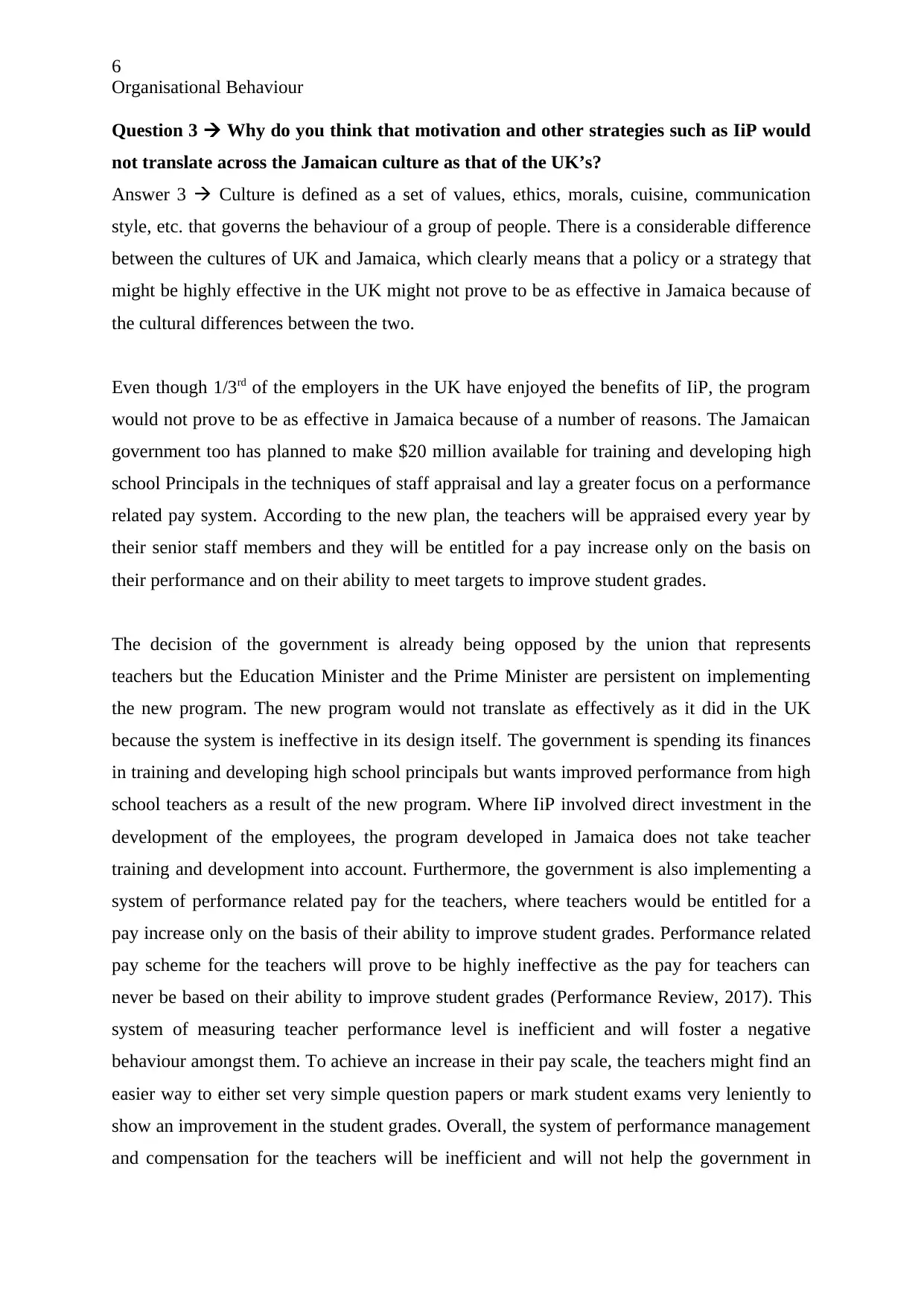
6
Organisational Behaviour
Question 3 Why do you think that motivation and other strategies such as IiP would
not translate across the Jamaican culture as that of the UK’s?
Answer 3 Culture is defined as a set of values, ethics, morals, cuisine, communication
style, etc. that governs the behaviour of a group of people. There is a considerable difference
between the cultures of UK and Jamaica, which clearly means that a policy or a strategy that
might be highly effective in the UK might not prove to be as effective in Jamaica because of
the cultural differences between the two.
Even though 1/3rd of the employers in the UK have enjoyed the benefits of IiP, the program
would not prove to be as effective in Jamaica because of a number of reasons. The Jamaican
government too has planned to make $20 million available for training and developing high
school Principals in the techniques of staff appraisal and lay a greater focus on a performance
related pay system. According to the new plan, the teachers will be appraised every year by
their senior staff members and they will be entitled for a pay increase only on the basis on
their performance and on their ability to meet targets to improve student grades.
The decision of the government is already being opposed by the union that represents
teachers but the Education Minister and the Prime Minister are persistent on implementing
the new program. The new program would not translate as effectively as it did in the UK
because the system is ineffective in its design itself. The government is spending its finances
in training and developing high school principals but wants improved performance from high
school teachers as a result of the new program. Where IiP involved direct investment in the
development of the employees, the program developed in Jamaica does not take teacher
training and development into account. Furthermore, the government is also implementing a
system of performance related pay for the teachers, where teachers would be entitled for a
pay increase only on the basis of their ability to improve student grades. Performance related
pay scheme for the teachers will prove to be highly ineffective as the pay for teachers can
never be based on their ability to improve student grades (Performance Review, 2017). This
system of measuring teacher performance level is inefficient and will foster a negative
behaviour amongst them. To achieve an increase in their pay scale, the teachers might find an
easier way to either set very simple question papers or mark student exams very leniently to
show an improvement in the student grades. Overall, the system of performance management
and compensation for the teachers will be inefficient and will not help the government in
Organisational Behaviour
Question 3 Why do you think that motivation and other strategies such as IiP would
not translate across the Jamaican culture as that of the UK’s?
Answer 3 Culture is defined as a set of values, ethics, morals, cuisine, communication
style, etc. that governs the behaviour of a group of people. There is a considerable difference
between the cultures of UK and Jamaica, which clearly means that a policy or a strategy that
might be highly effective in the UK might not prove to be as effective in Jamaica because of
the cultural differences between the two.
Even though 1/3rd of the employers in the UK have enjoyed the benefits of IiP, the program
would not prove to be as effective in Jamaica because of a number of reasons. The Jamaican
government too has planned to make $20 million available for training and developing high
school Principals in the techniques of staff appraisal and lay a greater focus on a performance
related pay system. According to the new plan, the teachers will be appraised every year by
their senior staff members and they will be entitled for a pay increase only on the basis on
their performance and on their ability to meet targets to improve student grades.
The decision of the government is already being opposed by the union that represents
teachers but the Education Minister and the Prime Minister are persistent on implementing
the new program. The new program would not translate as effectively as it did in the UK
because the system is ineffective in its design itself. The government is spending its finances
in training and developing high school principals but wants improved performance from high
school teachers as a result of the new program. Where IiP involved direct investment in the
development of the employees, the program developed in Jamaica does not take teacher
training and development into account. Furthermore, the government is also implementing a
system of performance related pay for the teachers, where teachers would be entitled for a
pay increase only on the basis of their ability to improve student grades. Performance related
pay scheme for the teachers will prove to be highly ineffective as the pay for teachers can
never be based on their ability to improve student grades (Performance Review, 2017). This
system of measuring teacher performance level is inefficient and will foster a negative
behaviour amongst them. To achieve an increase in their pay scale, the teachers might find an
easier way to either set very simple question papers or mark student exams very leniently to
show an improvement in the student grades. Overall, the system of performance management
and compensation for the teachers will be inefficient and will not help the government in
⊘ This is a preview!⊘
Do you want full access?
Subscribe today to unlock all pages.

Trusted by 1+ million students worldwide

7
Organisational Behaviour
motivating them. It would rather foster a negative behaviour in the teachers and might also
demotivate them in the long run (Kettner, 2017).
Organisational Behaviour
motivating them. It would rather foster a negative behaviour in the teachers and might also
demotivate them in the long run (Kettner, 2017).
Paraphrase This Document
Need a fresh take? Get an instant paraphrase of this document with our AI Paraphraser
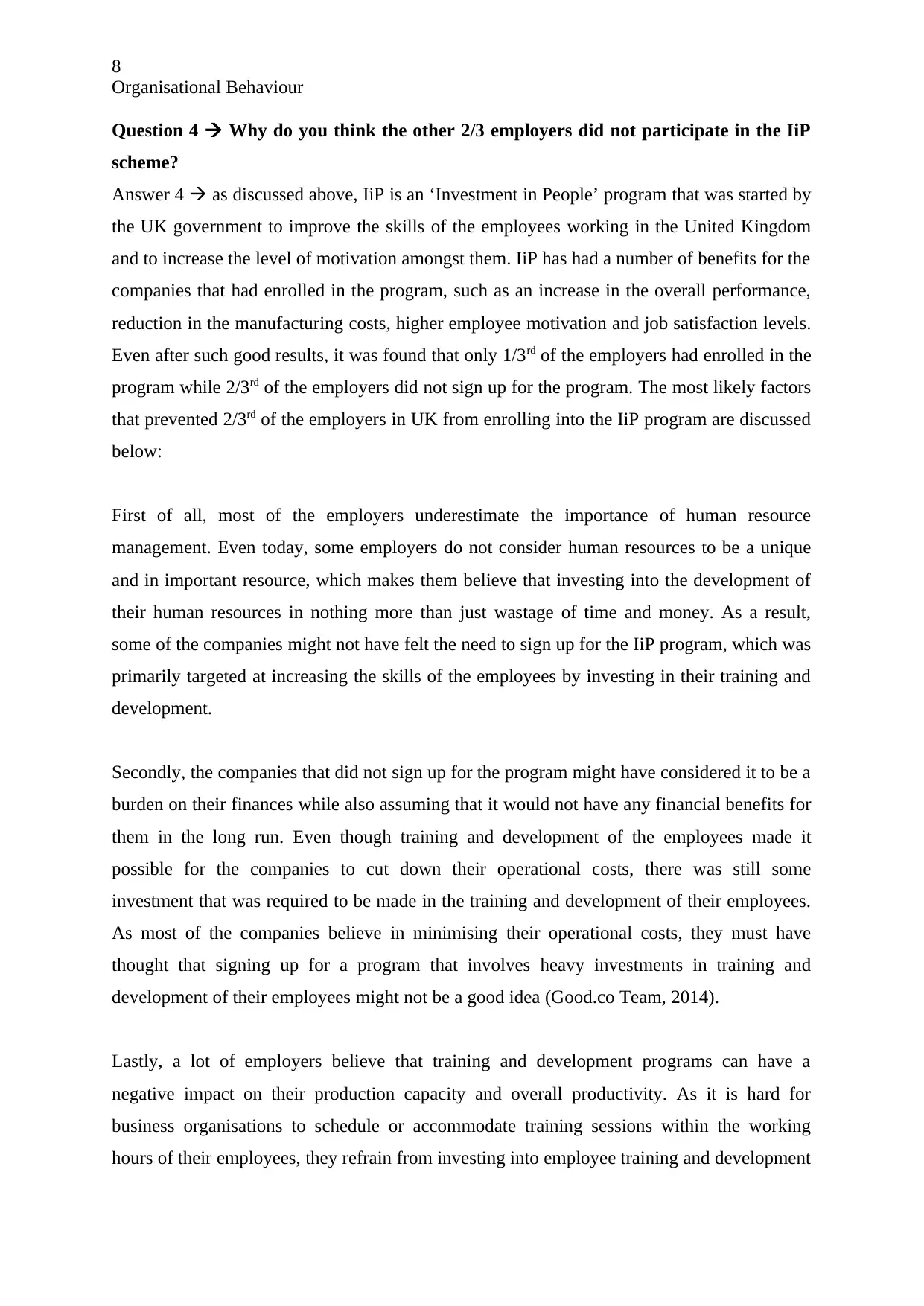
8
Organisational Behaviour
Question 4 Why do you think the other 2/3 employers did not participate in the IiP
scheme?
Answer 4 as discussed above, IiP is an ‘Investment in People’ program that was started by
the UK government to improve the skills of the employees working in the United Kingdom
and to increase the level of motivation amongst them. IiP has had a number of benefits for the
companies that had enrolled in the program, such as an increase in the overall performance,
reduction in the manufacturing costs, higher employee motivation and job satisfaction levels.
Even after such good results, it was found that only 1/3rd of the employers had enrolled in the
program while 2/3rd of the employers did not sign up for the program. The most likely factors
that prevented 2/3rd of the employers in UK from enrolling into the IiP program are discussed
below:
First of all, most of the employers underestimate the importance of human resource
management. Even today, some employers do not consider human resources to be a unique
and in important resource, which makes them believe that investing into the development of
their human resources in nothing more than just wastage of time and money. As a result,
some of the companies might not have felt the need to sign up for the IiP program, which was
primarily targeted at increasing the skills of the employees by investing in their training and
development.
Secondly, the companies that did not sign up for the program might have considered it to be a
burden on their finances while also assuming that it would not have any financial benefits for
them in the long run. Even though training and development of the employees made it
possible for the companies to cut down their operational costs, there was still some
investment that was required to be made in the training and development of their employees.
As most of the companies believe in minimising their operational costs, they must have
thought that signing up for a program that involves heavy investments in training and
development of their employees might not be a good idea (Good.co Team, 2014).
Lastly, a lot of employers believe that training and development programs can have a
negative impact on their production capacity and overall productivity. As it is hard for
business organisations to schedule or accommodate training sessions within the working
hours of their employees, they refrain from investing into employee training and development
Organisational Behaviour
Question 4 Why do you think the other 2/3 employers did not participate in the IiP
scheme?
Answer 4 as discussed above, IiP is an ‘Investment in People’ program that was started by
the UK government to improve the skills of the employees working in the United Kingdom
and to increase the level of motivation amongst them. IiP has had a number of benefits for the
companies that had enrolled in the program, such as an increase in the overall performance,
reduction in the manufacturing costs, higher employee motivation and job satisfaction levels.
Even after such good results, it was found that only 1/3rd of the employers had enrolled in the
program while 2/3rd of the employers did not sign up for the program. The most likely factors
that prevented 2/3rd of the employers in UK from enrolling into the IiP program are discussed
below:
First of all, most of the employers underestimate the importance of human resource
management. Even today, some employers do not consider human resources to be a unique
and in important resource, which makes them believe that investing into the development of
their human resources in nothing more than just wastage of time and money. As a result,
some of the companies might not have felt the need to sign up for the IiP program, which was
primarily targeted at increasing the skills of the employees by investing in their training and
development.
Secondly, the companies that did not sign up for the program might have considered it to be a
burden on their finances while also assuming that it would not have any financial benefits for
them in the long run. Even though training and development of the employees made it
possible for the companies to cut down their operational costs, there was still some
investment that was required to be made in the training and development of their employees.
As most of the companies believe in minimising their operational costs, they must have
thought that signing up for a program that involves heavy investments in training and
development of their employees might not be a good idea (Good.co Team, 2014).
Lastly, a lot of employers believe that training and development programs can have a
negative impact on their production capacity and overall productivity. As it is hard for
business organisations to schedule or accommodate training sessions within the working
hours of their employees, they refrain from investing into employee training and development

9
Organisational Behaviour
programs believing that it might lower down their productivity because of the reduced
working hours. (Strutton, 2015)
Organisational Behaviour
programs believing that it might lower down their productivity because of the reduced
working hours. (Strutton, 2015)
⊘ This is a preview!⊘
Do you want full access?
Subscribe today to unlock all pages.

Trusted by 1+ million students worldwide
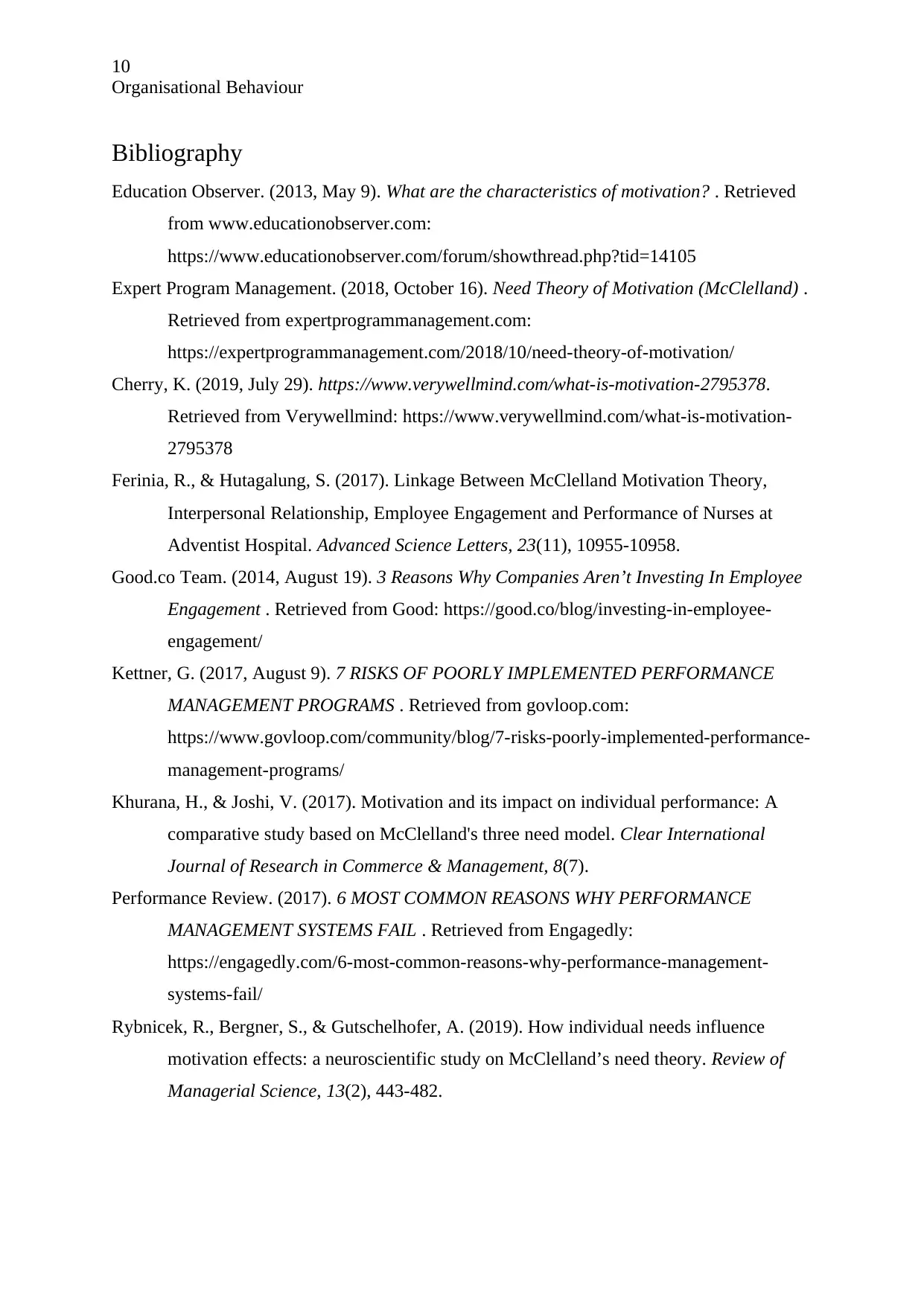
10
Organisational Behaviour
Bibliography
Education Observer. (2013, May 9). What are the characteristics of motivation? . Retrieved
from www.educationobserver.com:
https://www.educationobserver.com/forum/showthread.php?tid=14105
Expert Program Management. (2018, October 16). Need Theory of Motivation (McClelland) .
Retrieved from expertprogrammanagement.com:
https://expertprogrammanagement.com/2018/10/need-theory-of-motivation/
Cherry, K. (2019, July 29). https://www.verywellmind.com/what-is-motivation-2795378.
Retrieved from Verywellmind: https://www.verywellmind.com/what-is-motivation-
2795378
Ferinia, R., & Hutagalung, S. (2017). Linkage Between McClelland Motivation Theory,
Interpersonal Relationship, Employee Engagement and Performance of Nurses at
Adventist Hospital. Advanced Science Letters, 23(11), 10955-10958.
Good.co Team. (2014, August 19). 3 Reasons Why Companies Aren’t Investing In Employee
Engagement . Retrieved from Good: https://good.co/blog/investing-in-employee-
engagement/
Kettner, G. (2017, August 9). 7 RISKS OF POORLY IMPLEMENTED PERFORMANCE
MANAGEMENT PROGRAMS . Retrieved from govloop.com:
https://www.govloop.com/community/blog/7-risks-poorly-implemented-performance-
management-programs/
Khurana, H., & Joshi, V. (2017). Motivation and its impact on individual performance: A
comparative study based on McClelland's three need model. Clear International
Journal of Research in Commerce & Management, 8(7).
Performance Review. (2017). 6 MOST COMMON REASONS WHY PERFORMANCE
MANAGEMENT SYSTEMS FAIL . Retrieved from Engagedly:
https://engagedly.com/6-most-common-reasons-why-performance-management-
systems-fail/
Rybnicek, R., Bergner, S., & Gutschelhofer, A. (2019). How individual needs influence
motivation effects: a neuroscientific study on McClelland’s need theory. Review of
Managerial Science, 13(2), 443-482.
Organisational Behaviour
Bibliography
Education Observer. (2013, May 9). What are the characteristics of motivation? . Retrieved
from www.educationobserver.com:
https://www.educationobserver.com/forum/showthread.php?tid=14105
Expert Program Management. (2018, October 16). Need Theory of Motivation (McClelland) .
Retrieved from expertprogrammanagement.com:
https://expertprogrammanagement.com/2018/10/need-theory-of-motivation/
Cherry, K. (2019, July 29). https://www.verywellmind.com/what-is-motivation-2795378.
Retrieved from Verywellmind: https://www.verywellmind.com/what-is-motivation-
2795378
Ferinia, R., & Hutagalung, S. (2017). Linkage Between McClelland Motivation Theory,
Interpersonal Relationship, Employee Engagement and Performance of Nurses at
Adventist Hospital. Advanced Science Letters, 23(11), 10955-10958.
Good.co Team. (2014, August 19). 3 Reasons Why Companies Aren’t Investing In Employee
Engagement . Retrieved from Good: https://good.co/blog/investing-in-employee-
engagement/
Kettner, G. (2017, August 9). 7 RISKS OF POORLY IMPLEMENTED PERFORMANCE
MANAGEMENT PROGRAMS . Retrieved from govloop.com:
https://www.govloop.com/community/blog/7-risks-poorly-implemented-performance-
management-programs/
Khurana, H., & Joshi, V. (2017). Motivation and its impact on individual performance: A
comparative study based on McClelland's three need model. Clear International
Journal of Research in Commerce & Management, 8(7).
Performance Review. (2017). 6 MOST COMMON REASONS WHY PERFORMANCE
MANAGEMENT SYSTEMS FAIL . Retrieved from Engagedly:
https://engagedly.com/6-most-common-reasons-why-performance-management-
systems-fail/
Rybnicek, R., Bergner, S., & Gutschelhofer, A. (2019). How individual needs influence
motivation effects: a neuroscientific study on McClelland’s need theory. Review of
Managerial Science, 13(2), 443-482.
Paraphrase This Document
Need a fresh take? Get an instant paraphrase of this document with our AI Paraphraser

11
Organisational Behaviour
Strutton, J. (2015, August 4). Why companies fail to train their employees . Retrieved from
ISHN: https://www.ishn.com/articles/102005-why-companies-fail-to-train-their-
employees
Organisational Behaviour
Strutton, J. (2015, August 4). Why companies fail to train their employees . Retrieved from
ISHN: https://www.ishn.com/articles/102005-why-companies-fail-to-train-their-
employees
1 out of 11
Related Documents
Your All-in-One AI-Powered Toolkit for Academic Success.
+13062052269
info@desklib.com
Available 24*7 on WhatsApp / Email
![[object Object]](/_next/static/media/star-bottom.7253800d.svg)
Unlock your academic potential
Copyright © 2020–2025 A2Z Services. All Rights Reserved. Developed and managed by ZUCOL.


